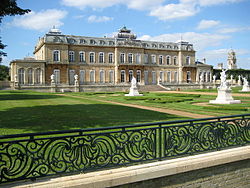Wrest Park
| Wrest Park | |
| Bedfordshire | |
|---|---|
 Wrest House, from the south | |
| Location | |
| Grid reference: | TL08983563 |
| Location: | 52°0’29"N, 0°24’44"W |
| Village: | Silsoe |
| History | |
| Country house | |
| Information | |
| Owned by: | English Heritage |
| Website: | Wrest Park |
Wrest Park is a country house and estate near Silsoe in Bedfordshire. The house is today a Grade I listed mansion, and surrounding it are Wrest Park Gardens, also Grade I listed. All is in the care of English Heritage.
History
Thomas Carew (1595–1640) wrote his country house poem "To My Friend G.N. from Wrest" in 1639 that described the old house which was demolished between 1834 and 1840.


The present house was built in 1834–39, to designs by its owner Thomas de Grey, 2nd Earl de Grey, an amateur architect and the first president of the Royal Institute of British Architects, who was inspired by buildings he had seen on trips to Paris. He based his house on designs published in French architectural books such as Jacques-François Blondel's Architecture Française (1752). The works were superintended as clerk of works on site by James Clephan,[1] who had been clerk of the works at the Liddell seat, Ravensworth Castle in County Durham, and had recently served as professional amanuensis and builder for Lord Barrington. Although Nikolaus Pevsner previously stated that Clephan was a French architect who designed the present house instead of De Grey the amateur architect, as Charles Read has shown in his biography of De Grey, Clephan (born Clapham) in fact only produced drawings of the service infrastructure, such as plumbing and drainage. The decorative layout and features of the house were produced by De Grey's own hand.[2]
Wrest has some of the earliest Rococo Revival interiors in Britain. Reception rooms in the house are open to the public.
Wrest Park Gardens

Wrest Park has an early eighteenth-century garden, spread over 92 acres,[3] which was probably originally laid out by George London and Henry Wise for Henry Grey, 1st Duke of Kent, then modified by Lancelot "Capability" Brown in a more informal landscape style.
The park is divided by a wide gravel central walk, continued as a long canal that leads to a Baroque pavilion banqueting house designed by Thomas Archer and completed in 1711. The interior of the pavilion is decorated with an impressive Ionic columns in trompe-l'œil. Boundary canals were altered to take the more natural shape by Capability Brown, who worked there between 1758 and 1760, and who also ringed the central formal area with a canal and woodland. The gardens and garden houses were mapped by John Rocque in 1735.[4] During the later 18th and 19th centuries, the Bath House, an orangery and marble fountains were added.
A Wellingtonia (Sequoiadendron giganteum) planted in 1856 was in its earlier years brought into the house annually to serve as a Christmas tree, one of the earliest surviving examples known in the U.K.[5]
Restoration programme
In the autumn of 2007 English Heritage announced that the Wolfson Foundation had pledged up to £400,000 towards the restoration of a number of the key features of the Wrest Park estate, including the mansion's formal entrance area, the garden statuary, railings and gates, and to alter the height of the carriage drive. In the next phases the lakes and canals will be restored.
On 12 September 2008 English Heritage unveiled extensive plans to restore the Grade-I-listed Wrest Park house and gardens to their original splendour.[6] In 2008 the music video for "The Fear" by Lily Allen featured interior as well as exterior scenes of Wrest Park.
In July 2011 English Heritage completed work on a new visitors' centre, car parking, exhibition space and accessible paths.[7] and the park opened to the public on 4 August 2011.[8]
Capability Brown memorial

There is a memorial column dedicated to Lancelot "Capability" Brown. It was originally placed near the Bowling Green House, which was remodelled by Batty Langley in 1735, but is now located in the eastern part of the gardens. The column has the inscription: "These gardens, originally laid out by Henry Duke of Kent, were altered by Philip Earl of Hardwicke and Jemima Marchioness Grey with the professional assistance of Lancelot Brown Esq. in the years 1758, 1759, 1760."
Outside links
| ("Wikimedia Commons" has material about Wrest Park) |
- Wrest Park – English Heritage
References
- ↑ Country Life, 25 June and 2 July 1970, noted in Howard Colvin, A Biographical Dictionary of British Architects 1600-1840 3rd ed. 1995: "James Clephan".
- ↑ Charles Read, "Earl de Grey" (2007) pp. 21-24
- ↑ "Wrest Park reopens after £1.14m restoration". BBC News. 2011-08-02. http://www.bbc.co.uk/news/uk-england-beds-bucks-herts-14371970.
- ↑ Rocque catalogue: 5.
- ↑ "'Oldest' Christmas tree at Wrest Park to be decorated". BBC News. 2014-12-02. http://www.bbc.co.uk/news/uk-england-beds-bucks-herts-30272863. Retrieved 2014-12-02.
- ↑ 20-year plan to restore Wrest Park's gardens Bedford Today
- ↑ "Future of magnificent garden secured/". English Heritage. http://www.english-heritage.org.uk/about/news/future-of-magnificent-garden-secured/. Retrieved 6 March 2011.
- ↑ 'Secret garden' Wrest Park reopens after restoration - The Guardian 2 August 2011, accessed 2 August 2011
- Nicola Smith, Wrest Park (1995), London: English Heritage, ISBN 1-85074-481-5
- Linda Cabe Halpern, "Wrest Park 1686–1730s: exploring Dutch influences" in Garden History Journal, Vol 30. No 2 (2002)
- Jean O’Neill, "John Rocque as a guide to gardens" in Garden History Journal, Vol 16, Np 1
- James Collett-White, "Inventories of Bedfordshire Country Houses 1714-1830" in Bedfordshire Historical Record Society, Vol 74, 1995
- Charles Read, "Earl de Grey", London: Willow Historical Monographs. 2007 ISBN 978-0-9555693-0-2
- A. F. Cirket (ed.), "The Earl de Grey's account of the building of Wrest House" in Bedfordshire Historical Record Society, Volume 59, 1980